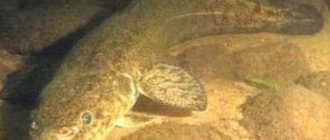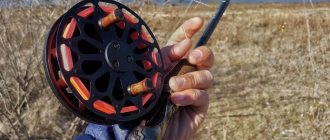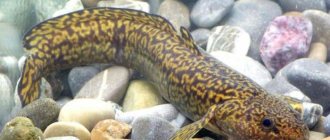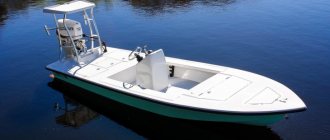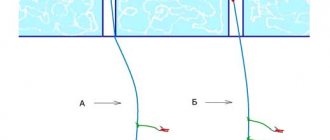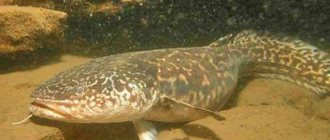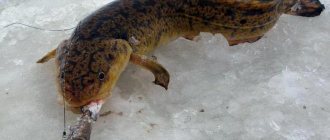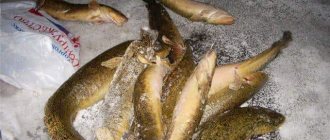Catching burbot with mugs: effective ways to catch burbot
Catching burbot with mugs is not as interesting as many other methods of catching this wonderful fish, but you should not forget about this method.
Such fishing can only be effective if we have chosen the right place and found the right bait.
Finding burbot is not as easy as it seems, but the thing is that it is a secretive fish and, as a rule, leads a nocturnal lifestyle.
Well, let’s not delve into the specifics of the behavior of our slippery friend, but let’s move on to the specifics of fishing with mugs. All fishermen who have at least once engaged in such fishing for pike probably know what mugs are.
The circle is a small round platform and a low leg, to which the fishing line is actually attached. When biting, the circle turns over, which notifies the angler about the activity of the fish.
The only, in my opinion, significant disadvantage of circles is that they are caught with this tackle during the day, and during the day, as you know, burbot does not really like to feed.
If we set the mugs at night, then we will have to ride the boat every now and then and see what’s going on with the gear. We won’t attach a flashlight, after all.
Another important point when catching burbot with mugs is the correct choice of mug. The circle should be light and not very large, so that the fish can easily turn it over.
Advantages of gear
A bottom with an elastic band when fishing for burbot in the fall is good because the live bait is delivered alive to the fishing site, whereas when casting a “throwaway” they can die or fly off the hook when they hit the water. And although many fishermen claim that burbot bites better on dead fish, practice confirms that there are more burbot bites on lively baitfish.
Read! Catching burbot on girders in winter
Catching burbot using baits: effective ways to catch burbot
Postavushki are a completely different matter; they can be placed both during the day and at night. The advantage is that we place the supplies close to the shore, or rather precisely on the shore at the moment when the entire main part is in the Water.
The supply can be an ordinary willow twig, and finally, with which the main fishing line is attached to a loop. When bitten, the branch bends, signaling very well.
The second option is used in winter for ice fishing. It looks like this:
A cross-shaped connection is made, finally, nuts are attached to one stick, one or two does not matter. A fishing line 0.2 thick and a sinker with a hook are passed through the nuts.
The part with the nuts is placed above the hole; when biting, the nuts are rebalanced and the stick stands vertically. Very simple, but so effective. The most important thing is that if there are no bites for a long time, do not linger in one place, but move across the pond in search of a catching point.
Effective baits for burbot: tested from personal experience
Don't forget to change the bait often, sometimes it works great. Although many claim that the burbot is a scavenger, we should not forget that this fish is not averse to eating a fresh piece of meat.
With such baits it is best to use hooks with a long shank. On a short fore-end, the bait will be held dead, and we need the bait to have at least some freedom of movement.
When bitten, the burbot begins to slowly swallow the bait, and if it feels resistance, it will instantly spit out the bait. This does not happen on a hook with a long shank. Tested by personal experience.
You shouldn’t do a hook when you’re biting on a circle, but you should when you’re setting a hook, since fishing with this type of gear is carried out at shallow depths. The main thing is to react immediately.
If fishing for burbot is carried out at great depths, then you can bleed off some part of the fishing line, and only then hook it. This way the fish will swallow the bait better and have less chance of escape.
Do-it-yourself burbot baits. Quick and easy (video)
Where to install gear?
I recommend installing a donk with an elastic band for burbot only in those places where you have already been hooked by these predators more than once. Frequent bites in one place indicate that there is probably a burbot trail along which this predator goes out at night in search of food. Often, if the nature of the flow and water relief in a reservoir does not change, burbots visit such trails for years. At the same time, it may not appear in neighboring areas, which also seem visually suitable for fishing, for many years.
Read! Catching burbot
Donka with rubber shock absorber: simple and effective tackle
Mid-October, strong gusty winds, constant precipitation, in general, the weather is brilliant. A normal person sits at home under a warm blanket and drinks hot tea, but not an avid fisherman.
We pick up a donkey with a rubber shock absorber and go to the nearest body of water with burbot on it. Burbot escapes from such a bottom much less often, because the shock absorber dampens all jerks of the fish. All we can do is simply drag the fish to the shore.
The gear looks quite simple:
A rubber shock absorber of the required diameter is attached to an ordinary donkey. In my case it is 0.2 and 0.18;
The shock absorber is selected depending on the size of the intended trophy;
If necessary, the elastic band can be equipped with replaceable leashes, which makes fishing much easier.
When fishing with a donkey with a rubber shock absorber, the same attachments are used as when fishing with a regular donkey, and when fishing for burbot in winter.
When and how to catch burbot in reservoirs?
Depending on the chosen method of catching burbot, fishing is mostly carried out from the coastline. The time for fishing will vary for different methods, but the places are the same.
Spinning
Fishing of the water area is carried out after sunset, but before darkness, so that faint traces of detection can be noticed. Ideal places are shallows with a sandy bottom and shallow depths with small pebbles close to the shore.
Zakidushka
The casting of the tackle is carried out at approximately the same time, and it will remain there until the morning. Usually several rods are used at once, which are cast at different distances relative to the shore. This way you can capture a larger area for fishing, thereby increasing the chances of a trophy specimen.
Catching burbot with a float rod
Catching burbot with a fishing rod is very interesting, since we can see the bite visually. Everyone knows that many fish bite differently.
Burbot bites as follows:
He takes the bait and slowly pulls it to the bottom without doing any unnecessary actions. Burbot does not have such twitches as in roach or crucian carp. The entire bite looks like a monotonous lowering of the float antenna under the water.
It is best to catch burbot with a fishing rod in the evening in the coastal zone. The most important thing is to choose the right fishing point.
Burbot loves shell rock and pebble bottom. Finding such a place is very simple, and if you do find this point, you will not be left without a catch.
To catch burbot, you will need a parabolic rod with a soft tip that is responsive to all manipulations.
The main fishing line should be monofilament, with a diameter of 0.18 mm and no more.
You don’t have to install a leash, and if you do, use fluorocarbon of a smaller diameter than the main line.
The attachment is a worm or a small piece of cut fish.
Installation and equipment of donkeys for burbot
For fishing with bottom tackle, devices of various designs are used. The most popular options for catching burbot are products with two leads, but in some cases a large catch can be obtained using single-lead gear.
How to catch more fish?
I have been active fishing for quite some time and have found many ways to improve the bite. And here are the most effective:
- Bite activator. Attracts fish in cold and warm water with the help of pheromones included in the composition and stimulates its appetite. It’s a pity that Rosprirodnadzor wants to impose a ban on its sale.
- More sensitive gear. Reviews and instructions for other types of gear can be found on the pages of my website.
- Lures using pheromones.
You can get the rest of the secrets of successful fishing for free by reading our other articles on the site.
With one leash
Such a device consists of:
- fishing line with a diameter of 0.5-0.6 mm;
- massive sinker;
- one leash with a hook, a braided cord with a diameter of 2.1-2.5 mm can be used.
The hook must be made of hardened steel with a long shank and a sharp sting.
The sharpness of the sting must be constantly monitored, preventing it from becoming dull. Installing a donkey for catching burbot is very simple:
- It is necessary to install a sinker on the main fishing line 40-60 meters long.
- At a distance of 20 cm from the sinker, tie a leash with a hook. The length of the leash usually does not exceed 15 cm, so it is not allowed to overlap with the sinker, and the bait will always be at the bottom of the reservoir, which will significantly increase the likelihood of bites.
- The finished tackle is wound on a reel, which is made of a wooden board 30–40 cm long.
- If a spinning rod is used to catch fish, then the fishing line must be threaded through all the guide rings of the rod and wound onto the reel.
With two leashes
This type of donkey differs from the first option by the presence of an additional leash, which is attached to the main fishing line. Usually it is attached at a distance of 30 cm from the first leash. The length of the second should be slightly longer and is usually in the range of 20-25 cm.
When using double-lead donks, you can more accurately determine the gastronomic preferences of the fish.
To do this, use a different bait on each leash of the bait. Which hook will get the most bites, that bait is used for hunting burbot.
Burbot fishing in spring: in search of active burbot
Spring fishing for burbot begins after the ice melts, at a time when the water begins to brighten.
It is at this moment that you should pick up your gear and go to deep rivers in search of such wonderful fish as burbot.
In the spring, he behaves actively, since 1.5 months ago he only spawned eggs. After spawning, burbot gets sick for a long time. And after this condition passes, he begins to actively feed, exploring every millimeter in search of food.
Burbot feeds on small fish, crustaceans and bloodworms. The nocturnal predator approaches its prey with lightning speed, one second and the gaping fish ends up in its mouth.
In the spring, this fish moves to shallower water areas, where it actually spends most of its time. With the onset of dusk, the fish come out to the shallows, sometimes moving to the spits. It’s very easy to catch burbot at night, the main thing is to find just such a trump spot.
I like to catch burbot on 2 rivers: Don and Volga. There are a lot of burbot in both places and there are no problems with the search, but sometimes something incomprehensible happens and the slippery beauty refuses the bait for a short distance.
Catching Burbot on Donka. Tackle and Nozzle. Video
Fishing for Burbot on Donka is possible in 3 periods: Autumn, winter and spring. Unless, of course, in your area there are deep-sea reservoirs or clean, cold rivers, the water in which, even in the summer sun, does not warm up to a temperature above 12 degrees Celsius.
In such reservoirs, burbot can be caught even in summer, mixed with other predators.
237 kg. large fish in the middle of nowhere from 1 hole!
The detained fishermen told the secret of a good bite. The fishery inspectors were surprised by the lack of prohibited equipment.
Catching burbot with microjig. Methods for catching burbot
In the spring, I catch burbot using 2 interesting methods, one of which is so specific that most anglers would not even try to catch this fish.
That’s what they tell me: you need to catch other fish, but not burbot. This method is microjig.
I successfully catch a variety of fish with jigs, but I just recently switched to microjigs and this is the result! In my understanding, a microjig is a super light class rod and a reel with a thin braided line.
As for the spinning rod, it is a 1.90-long stick with a dough from 2 to 10 g;
Reel size 1000 or 1500, according to the Shiman classification;
As the main fishing line, I use braided line with a diameter of 0.04 millimeters.
How to make donka for burbot
The casting for burbot is stored on a wooden reel made of a 20 mm thick board with dovetail-shaped end slots, which serve to conveniently wind up the thread and prevent its spontaneous discarding. The main cord is a 0.3 mm thick nylon line. For one installation unit you will need a piece of fishing line no more than 30 meters. For the load, lead blanks of flat shapes with masses are used that make it possible to hold the equipment in the current in the fished body of water. It is more practical to use the weight in a sliding principle of action, which makes the equipment less rough and does not cause excessive suspicion in the fish when biting. At the end of the main line, install a leash with a diameter of 0.20 to 0.25 mm and a length of 15–20 cm.
Important! Hooks in burbot fishing are used with a long shank, regardless of the type of bait, ranging from 8 to 14 units. The long fore-end helps to remove the hook more efficiently after swallowing the bait.
The equipment of the donkey assembled on the rod is identical to the composition of the hook, only instead of nylon fishing line, a braided cord is used as the base. The diameter of the fishing line varies from 0.15 to 0.20 mm. Inertia-free coils are used in the simplest versions, without unnecessary functions. A coarse clutch and a spool are enough to store about 100 meters of cord. The rod is used with medium or semi-slow action, with weights starting from 30 grams. The length of three meters covers any fishing distance.
Important! For burbot fishing, it is recommended to prepare a supply of leashes with hooks in advance in order to save time when removing deep-swallowed hooks by installing new leash equipment into the effective installation.
Jig baits for burbot
When it comes to baits, this is where the fun begins. A microjig is, instead of a standard jig head, a 2-gram jig with a bait attached to the end.
As usual, I don’t buy special baits, but cut them myself. I take edible rubber, in my case, this is not the little-known Tioga from Lucky John and Mr. Grady from the same company.
I cut the rubber into small thin strips, but I fit it in different ways. There are reasons for this. I can just plant it like a maggot at the very edge. Then she gets more freedom, and I can completely leave the small, barely moving tip.
I use the first method when the fish are very active;
And the second, with a low bite, almost zero.
Sometimes I play with flowers. In sunny weather I use dark shades, and in rainy weather, acid helps me out. The most universal color is white.
I treat jigs with special trepidation, sometimes I make them myself out of boredom. I really like dark tungsten jigs, they quickly sink to the bottom and thanks to them you can perform high-quality wiring.
By the way, wiring for burbot looks like this: after casting, let the bait sink to the bottom and do the wiring using the twitching method, only along the bottom. Interesting explosions are obtained, and the fish does not attack the bait so violently.
You can feel a bite on a microjig only if your spinning rod has a glued tip or if the tackle is super sensitive.
This happens because the burbot takes the bait with the tip of its mouth and holds it without making any effort. All that remains for us is to make a powerful hook without leaving the slightest chance for the fish.
To feel the cautious bites, you must constantly monitor the retrieve, keeping the line fully taut. A parabolic spinning rod will allow you to make high-quality retrieving, and a balanced reel and braid will eliminate the likelihood of fish disappearing.
Catching burbot with a side rod from a boat. Methods for catching burbot
The second no less interesting method is fishing from a boat, using an onboard fishing rod in a hole. The bottom line is that first I feed the point in small portions, and only then I start fishing.
Onboard fishing rods are sold in any fishing store; in extreme cases, you can make your own; for example, that’s what I did, making the first onboard fishing rod from a broken spinning rod at the wrong time.
The length of the fishing rod should be 30-40 centimeters. I attach an ordinary winter nod to the end of the rod; it is better if it is a vinyl tube of suitable diameter.
The main fishing line I use is monofilament, with a diameter of 0.2 millimeters. With a thick line it is much better to hook. But that is not all. The biggest advantage of fishing from a boat is the likelihood of catching a large specimen.
Now let's talk about the gear itself:
As previously mentioned, the main fishing line is 0.2, to the end of which a sinker is attached, used on a retractable leash. There are 3 leashes extending to the sides of the fishing line, on which a cut gudgeon is attached.
In spring, burbot activity shifts closer to lunch. Perhaps this is due to the fact that he has not yet fully recovered from caviar throwing.
During this period, burbot moves little around the water area, and if you feed it correctly, then consider that you have achieved the desired result. In the spring, it is caught using all bottom rig options, but I have described the most effective ones to you.
Finding burbot with an echo sounder: where to look for burbot?
One of the small problems that arises when fishing in spring is that when an angler goes out into deep water, he cannot get his bearings and very often returns not only without a burbot, but even without a single fish.
The thing is that such fishermen are so connected with old stereotypes that they are not even able to buy an echo sounder.
You shouldn’t go out on the water without an echo sounder, and measuring the bottom with a depth gauge is a long process and not always effective in large areas of water. After all, you still won’t be able to find the edge you’re interested in.
In the spring, burbot prefers to visit the spawning grounds of other fish, such as roach and silver bream. For this operation, he goes into relatively shallow water, thereby contradicting himself, what can’t you do for food.
In such places, I catch burbot on a 5-meter rigid rod with a side nod made of thick wire, since I use a small jig head with a nozzle in the form of a piece of meat flavored with an attractant as a hook.
Often, when fishing in spring, I was faced with a situation where the fish stopped biting during the daytime, although I was sure that I would catch it right now.
You shouldn’t despair, leave the tricks or supplies in place, and go home yourself, then come to this place in the evening and look at the result.
In addition to fresh fish, burbot also feed on carrion, and since no one checks the supply for a long time, the fish hooked will already emit an unpleasant odor.
Water speeds up the process of tissue decomposition. And that's why he's here. Do not forget that the nozzle should lie on the bottom and not hang in the water column. Burbot is a bottom-dwelling fish and will not rise from the very bottom for your bait, that’s the whole collapse.
Night fishing for burbot in spring. Why is it better at night?
Catching burbot at night is fundamentally different from daytime, in that completely different gear is used here.
On a spring night I prefer to catch it on a 3.60 m long feeder rod with a top weight of up to 100 grams. First I feed about 3 casts, and then I start fishing.
The bait is prepared on the basis of fish offal and cut worms; you can also flavor it with an attractant.
First, I choose the optimal point; it is best if there is an anomaly at the bottom (a snag or a submerged tree). I place the bait exactly in this place.
I take the distance to the point from the revolutions of the reel; in extreme cases, I secure the cord in a clip. I try to keep the feeder closer to the water surface and always keep the line taut.
When the burbot approaches the bait, it makes one, then a second jerk, and finally, the tip of the feeder bends into an arc.
The whip should be of medium flexibility. A very flexible one will not allow you to cut through the fleshy mouth, but with a medium, flexible tip, everything is different.
When fishing for burbot in the spring, I choose sedentary tactics, that is, I don’t move around the reservoir much in search of this fish. I immediately try to determine the correct point; the outcome of a fishing trip very often depends on this choice.
In spring, burbot is depleted, so don’t be surprised when you catch a specimen almost 1 meter tall, but weighing 1 kilogram. Until summer, this fish will still gain fat. Burbot will actively feed throughout the entire season until spawning.
With this, we can consider the story about spring burbot fishing over and move on to the 2nd season, which is of course no less interesting. I think you can guess that next we will talk about autumn.
Technique for catching burbot on a donk
Late in the evening we go to the chosen place. This, perhaps, is an area with steep banks and a drop-off or exit from deep holes with springs; burbot comes to such a road every night.
The bottom for burbot is unwound, an active live bait is attached to the hook, we cast. We select the slack in the line and secure it to a peg. We install an electronic or other backlit bite alarm to immediately identify the triggered donkey in the dark. Don't forget to take a flashlight.
Experienced fishermen claim that a lit fire or the light of a lantern attracts fish. After 30–60 minutes we check the gear. To do this, we gently pull the line and if we feel a jerk or heaviness, we smoothly hook the fish against the direction of the current.
If we fish from ice, everything is simple here too. Having drilled holes along the burbot trail, we lower the donks and cover the holes with circles. After a while we check the gear. We must replace damaged live bait or other types of bait if there are no bites.
The fish stubbornly resists, so we advise you to take a landing net to the pond in the fall and spring, and a hook in the winter. An extractor and a yawner will not be superfluous.
Fishing with a donkey is a passive form of catching predators. Be prepared to endure bad weather, sharp winds, rain and systematically check abandoned donks after a short period of time. The result is an excellent catch of burbot - this bottom-dwelling fish that loves cold water.
Source
Catching burbot in autumn
Unlike the spring season, autumn brings even more fruit, of course only for those who love to work.
Autumn burbot fishing is radically different from spring, the most significant difference is the place of fishing, and now from my story you will understand this.
In autumn, burbot, unlike in spring, occupies the deepest points. Such places can be holes, spits, dumps. In such places, burbot looks for fry and spends most of its time, rarely going out onto the shallows.
Since all the fry roll into the pits, the burbot has no motivation to leave the pits, especially our slippery, beautiful bottom-dwelling fish.
In the fall, burbot experiences an active pre-winter glutton, and our slippery friend is gaining weight. Since in mid-February, in severe frosts, it will spawn. But we’ll talk about this later, and now about catching it in the fall.
There is quite a lot of burbot in our rivers; it is also present in artificial reservoirs. But his behavior is much different.
Firstly, in artificial reservoirs, burbot is a by-catch, and not a targeted object of fishing;
Secondly, there is little of it on paid sites. Currently, it is rare to find private companies that purposefully breed burbot.
Some fishermen are completely disgusted by this fish, blaming everything on its appearance, saying: what a snake it is, and a slippery one at that. I treat burbot with respect.
And so, I start autumn fishing for this fish in mid-October and fish until the first frost. I have selected promising points in advance, since I devote the first day of fishing to reconnaissance and try to find the burbot trail.
No matter how trivial it may sound, it is true. Therefore, the first day of fishing should be devoted to fishing a large area of water, preferably making the longest casts.
We caught one burbot from the point, we moved on. If bites are repeated periodically in different places, then perhaps we have discovered the same trail.
Burbot leads a relatively sedentary lifestyle. Therefore, do not worry that the next day he will leave the detected point. It is advisable to feed the place before leaving, then 100% burbot will stay here for a long time.
Catching burbot on a donk
Bottom tackle allows you to catch fish during a certain period. You should not look for burbot in heated water. The best time for fishing is a stormy and cold night. This kind of fishing has several features, which will be discussed in our article.
A novice fisherman should know the habits of burbot, the choice of place and time of fishing, methods of selecting and making gear. This knowledge will help a beginner find the burbot “path” and cast the donk correctly. Fishing is not active, but the excitement and stubborn resistance of the prey makes it popular among fishermen.
Tackle for autumn fishing
Now let's talk about the gear I use, specifically in the fall.
In the fall, I prefer to fish with a light pickerel rod 3 meters long and with a weight of up to 40 grams. I use a drop shot or slug as my main sinker. Everyone knows how to attach a drop shot, but with a bullet you need to think about it.
I use the bullet only when the longest cast is required. The bullet is fixed on 2 silicone stoppers using a stop bead, this way I avoid breaking the equipment.
As the main line I use braid with a diameter of 0.1, it allows you to make a clear, high-quality hook. A flexible picker rod will allow you to easily bring out the trophy.
The equipment must be placed on the bottom with precision; you can, of course, miss a few centimeters from the chosen fishing point, but no more.
When I get tired of fishing with the same thing, I start experimenting, and one of my discoveries was the use of a rubber shock absorber in the equipment.
I attach the shock absorber between the sinker and the swivel, on which the fluorocarbon leash is attached. The shock absorber gives our equipment more freedom, it becomes more sensitive.
I use this type of tackle when burbot activity is low. When biting, the shock absorber lengthens the leash; this happens because the sinker remains at the bottom. And the shock absorber, if it is soft and well stretchable, pulls the leash towards the burbot. Burbot feels no resistance and quickly gets hooked.
What is the best time to catch burbot in the fall?
The best time to catch it in the fall is, of course, at night and before sunrise.
I catch burbot on the bottom starting at 10 p.m. I arrive early so that I have time to set up the gear before dark, which is something you can’t do for the sake of what you love.
In the morning, when the sun rises and slowly begins to warm up, and this moment comes around 9.00, then it’s worth changing the type of gear and switching to float fishing. Only here the tackle with a float will be specific.
The float will always be in a lying position. Finally, we attach a small Tyrolean stick, all advanced spinners know about it, so I won’t talk about it.
And so, we attach a fluorocarbon leash to the Tyrolean stick, at the end we place a hook No. 14 according to the Japanese classification and make a 2-3 cm hook from a small lead pellet.
I use a bunch of earthworms as bait, planting 3-4 of them at once. I don’t just attach it, but in a ring, so the worm looks very appetizing and the burbot likes it.
When the bite on this tackle also subsides, I simply move to another promising point or experiment with baits and attractants.
In general, you understand that catching burbot in the fall is very simple; just understand this specificity, and you will not be left without fish.
Catching burbot in the fall. Making donks (video)
Catching burbot in winter: methods from personal example
The winter season is probably the most successful for catching fish such as burbot.
In winter, burbot behaves actively during the period before spawning and during the spawning itself. For fishing, you should choose daytime between 10 and 12 hours.
The moment of biting depends on the reservoir, depth, lighting and even the transparency of the ice.
The fishing for burbot on the Don is amazing. And what kind of specimens do you come across in mid-February? Well, that’s probably enough verbatim, I’ll move on to one fishing incident at the exact moment when I was catching a mysterious burbot.
In this article I will talk about methods of catching burbot, give an example from personal experience, and you will understand that the winter season is the most catchy for this fish.
It was in February, I don’t remember the exact dates, but in a narrow circle of fishermen there was a rumor that burbot had begun to be caught well on the Don, as if old-time fishermen were carrying bags of fish home.
Looking at the calendar, I realized: perhaps, it’s the middle of February, the burbot is getting ready to spawn, let me think, I’ll try to catch something.
I went down to the garage and found the drill, the auger was in order, the cutters were in order, and what about the gear. I take out my a-elite box. So, well, you’ll probably have to go to the store first, buy a few jigs, and fluorocarbon for leashes and hooks with a long shank.
Before I could leave the garage, a friend rushes in and shows me a catch that I could never even dream of. A 50-kilogram bag of sugar was half filled with measured fish. There is only burbot in the catch.
He just came back from fishing and decided to drop by and tell you what’s going on. Well, we sat down and started talking, and from the conversation I realized that the burbot was really showing unprecedented activity.
Our conversation ended late in the evening, and I realized that I wouldn’t go fishing today. I agreed with a friend to go to the Don tomorrow, he hesitated briefly and agreed.
The next morning, after visiting the store and quickly equipping the girders, we went to the Don. We arrived quickly, unloaded, put on life preservers, and headed to the points just in case.
Which tackle for burbot is best to choose for a certain time of year?
Content
Each season is unique in its own way, causing fish to react to changes in water temperature. Successfully finding and catching fish is possible with proper understanding and knowledge of the habits of the prey. Despite the need for small changes in gear in the process of hunting for burbot, they play a decisive role in the effectiveness of fishing.
With proper understanding and knowledge of the habits of prey, it is possible to successfully find and catch fish
The method of catching burbot is different at each time of the year, so it is important to understand what the best gear for burbot is now:
- catching burbot in the spring. Spring fishing is divided into 2 periods: on ice and in open water. Predators can be caught from the ice using two methods: passive and active. In the first case, spinners are used, and in the second, a spinning rod with spinners is used. After the ice melts, bottom tackle for burbot from the shore in the spring becomes popular. Nowadays spinning rods with feeders and hooks are actively used. The main features of the choice of gear should be taken into account: the ability to catch depth and the accuracy of casting, because the bite can only be obtained when the bait is supplied to the fish trail;
- summer fishing. Warm periods for catching burbot are not very catchy; now the fish are passive. When fishing, girders and ordinary donks are often used; we leave them on the site for 1-3 days, only periodically checking the quality of the bait. The bites will be sporadic, it is important to realize them in time;
- autumn is the best season. Not only does catching burbot in the fall with a cast bring good results, now you can use almost all types of equipment. In the fall, a rattle is a popular rig for burbot, activating the fish and attracting the attention of the predator. Usually burbot is extremely lazy and difficult to catch, but in the fall the pre-spawning feast begins, forcing the predator to go out on a long night hunt. We choose the optimal tackle in the fall: bottom rig, bottom rig with elastic, float types of rig, girders;
- winter is an active time. During the winter bite there is good fish activity. Fishermen use flag bets and spinning rods with spoons (large specimens are often caught). It’s better to fish at night, setting up your gear before it gets dark and shooting with the first rays of the sun. The tapper rig is actively used; the technique involves tapping the bottom and taking long pauses of 30 seconds before attacking. We select a sluggish game without jerks.
Read more
How to catch crucian carp using a spring?
The method of catching burbot is different at each time of the year.
Finding burbot in winter: how to quickly find burbot?
We had to walk on ice for about 1 kilometer. And then I saw that all the ice had been drilled to such an extent that you were afraid to step on it in case it fell through.
But I quickly pushed these thoughts aside and did not notice how we arrived at the point. There were practically no holes here. I assemble the drill and begin to methodically drill holes in a checkerboard sequence; after drilling 10 holes, I stop.
I take out the same number of vents from the box and start installing them, doing everything carefully and slowly, so that later I don’t regret the mistakes I made while assembling the vents.
I use perch fry as bait. Too lazy to catch it myself, so I bought it at the store. Having planted live bait, I began to arrange the girders. Having arranged the gear, I sat down and waited for the bite.
So, the first one fired! As soon as I run up to the first one, the second and third ones are already sparkling with red flags on a white background. “What is it?” I said.
A solid pike was caught on the hook, so no one canceled the pike today. I run up to the triggered girders, the result is the same measured pike.
The toothy one came across every 3 minutes, if not less. Pike is good, but where is the burbot?
And then I realized, because we are running aground! I realized this when I once again set up the girder, the depth at the fishing spot was about one and a half meters, and you need to look for burbot in the pits.
It took my friend and I almost 2 hours to find such a point, now I understand why the ice on the Don is so drilled.
Having arrived at the point, I perform the same operation as at the previous point, that is, I bait the storm and wait for a bite. The first bite followed when the hope for success was already fading away, like a burning match.
And then a red light turned on, and I ran headlong in the hope that there was something there. And my feeling did not let me down; a kilos of burbot sat on the hook.
At this point the distribution ended, there was a long pause, I was almost upset when 3 zherlits worked at once.
All 3 burbots were successfully removed from under the ice. And then, towards evening, the real distribution began, he was caught one after another. Having caught almost 20 kg, I decided to stop, because you need to know when to stop. I’ll come here in 2 days, I thought, but with different gear.
And my friend and I went home. My friend also caught almost the same amount, but we had different fishing methods. He caught burbot on a small homemade spoon baited with chopped perch, and I caught it on a jig.
How to catch burbot on a donk
Catching burbot is also possible with artificial baits, such as spoons and balancers, but the simplest and most catchy bait for burbot remains live bait, and the most effective method and equipment is rightfully considered to be fishing for burbot on a donk.
If we describe the donkey for burbot schematically, then this tackle includes:
Catching burbot on a donk in winter
When fishing from ice, anglers usually use a line that is as long as the depth at the fishing spot, with a margin of about four meters. Since burbot is most often caught at night, the fishing line can be of any color.
Sinker for Rigging
Silent or running. A blind sinker is more often used for winter “plumb” fishing. A running weight, limited by stoppers, is used for fishing in open water conditions.
The shape and weight of the sinker completely depend on the strength of the current and the nature of the bottom in the fishing area. The only requirement for a sinker for catching burbot on a bottom is the ability to hold the rig in the current.
Traditionally, for open water fishing, sinkers weighing from 50 to 150 grams are used. For vertical fishing, 50 grams is the upper weight limit.
Leash on Burbot
For the leash in the rig, fishing line with a cross section of no less than 0.2 mm is used. To catch burbot, it is customary to use leashes no longer than 25 cm.
Hook
This element of equipment must, first of all, correspond to the size of the bait used in fishing. There are no special requirements for its appearance, shape, or color. The only thing you need to pay attention to is the length of the forend.
Hooks with a longer shank are easier to remove from the mouth of a night predator. Hooks made of thin wire are less likely to injure live bait. If we talk about sizes, it is customary to use hooks in the range No. 9 – No. 12 for catching burbot.
Bite alarm
In cases where a feeder rod is used to cast bait, a replaceable rod tip will signal the burbot bite. In all other cases, mechanical or electronic alarms are used.
Even novice anglers rarely have problems preparing a rod for burbot fishing. After the main line is wound onto the reel spool, a sinker is tied or attached.
In a donk designed for catching burbot, it is customary to use two hooks. Leashes with hooks are placed as follows:
– Leash No. 1 is knitted as a continuation of the main line. By the way, it is convenient to use the “swivel – carbine” system for attaching leashes; – Leash No. 2 is knitted above the sinker, at a distance of about 35 cm from it.
How to properly equip a vent? Methods for catching burbot
The equipment I had on the girder was as follows:
The main fishing line is monofilament, with a diameter of 0.22 millimeters, to which I attach a fluorocarbon leader, respectively 0.2 millimeters.
As a sinker, I use a bullet that is familiar to me. To prevent the bullet from running too much along the line, I stop it on both sides, making something like a 30-centimeter-long undercut. It is along this section of the fishing line that the bullet moves.
To prevent the live bait from floating too much above the bottom, I load the leash with a 3 gram shot. I connect the fishing line with the leash with a swivel, I choose hook No. 2 with a long shank, but a double is best. I attach the live bait behind my back, so that one hook clamps the second from the side.
At the moment of hooking, the live bait breaks off the hook, but both hooks eat into the fleshy mouth of the burbot. To hook this fish, you need to do a sweeping hook, and besides, fishing is done from a great depth of about 5 meters. In general, I told you about one method of fishing and gave an example.
Now I’ll try to tell you about the second no less interesting one, namely catching burbot with a vertical lure.
This is a kind of catching a predator with a spinning rod only from the ice, and besides, a small winter fishing rod acts as a spinning rod, and a micro-spinner acts as a spinner.
Catching burbot in winter for Christmas (video)
Types of gear for catching burbot
When choosing what gear to use to catch burbot, it is important to take into account the terrain, because not in all conditions it will be possible to realize the full potential of each gear. For example, casting for burbot in protracted shallow water rarely leads to bites, but lures allow you to make long casts and fish promising areas. We recommend that you always take into account the strength and presence of current, the depth of the reservoir, the type of bottom, and weather conditions; only then can we choose the best tackle for burbot for specific conditions.
Donka for catching burbot
Bottom tackle for burbot is one of the most catchy areas in autumn fishing. With the help of a donkey, it is possible to fish any deep-water places in large, medium and small reservoirs. Many fishermen prefer to make burbot gear adapted for a specific region of residence and fishing, since there are some differences in the terrain and the specifics of the reservoir.
The simplest donka is the zakidushka. Often a do-it-yourself bait is made from: reel, fishing line, sinker and bait. The tackle is attached to the shore by snags, trees or stones. There are modernized types of devices with fishing rods, guide rings and inertia.
Snack equipment:
- nylon fishing line with a diameter of 0.4 mm. Both monofilament and braid are used. Braided fishing line is more resistant to abrasion, stronger and more expensive. We can take fishing line that has already been removed from the spinning rod;
- The leashes are made from monofilament with a small diameter - 0.2-0.25 mm. They will help prevent the tackle from breaking during hooking. Steel leaders are not a necessary element, because the fish does not have too sharp teeth. It is advisable to install metal leader material on reservoirs with a large number of pikes;
- sinker. It is important to choose a sinker that can hold the tackle in one place under the influence of the sinker. Too large a load can scare away the fish, and a light one will lead to the demolition of the donkey.
One of the most catchy trends in autumn fishing is bottom tackle for burbot.
The Zakidushka has often been changed, redesigned and modernized; today there are a lot of gear designs, here are a few classic options:
- We immediately attach a sinker to the fishing line, and install a leash below. It is easy to assemble;
- We install the sinker at the end of the fishing line, attach the leashes slightly higher using a loop or swivel. It is more convenient to use when installing several leashes.
Read more
Catching perch on a retractable leash
Supplies for burbot
Deliveries are also called ice carriers. The gear is effective during night fishing, since in the dark of the day the holes quickly become overgrown with ice and freeze. The vent grows into the ice, making it difficult to remove. The supply is located in water, under a layer of ice, it does not grow in and is easier to remove.
The simplest scheme of tackle for burbot: a stick that fixes the tackle across the hole, a reel with fishing line, a hook and a weight. We install it all night, and when dawn approaches, we drill another hole close to the previous hole. We use a hook to pull the line towards us under the ice and retrieve the catch.
Tackle elements:
- fishing line with a diameter of 0.4-0.5 mm;
- sinker about 40 g;
- hook or several No. 10-12;
- the leash is 0.5 m long. The leash is based on a thin fishing line of 0.3-0.35 mm.
Important! When installing the tackle, you need to correctly determine the length of the fishing line; it should be 50-80 cm greater than the depth of the reservoir. If you set the length too long, after the hook, the burbot will begin to look for cover. Having given the prey a lot of freedom, he will find a hiding place from where he cannot be removed.
This gear is effective during night fishing.
Zherlitsy for burbot
Zherlitsy is a similar tackle for catching burbot, as well as rigs, they differ only in their fixation over the ice. They are a passive fishing gear used at low sub-zero temperatures, when the hole does not quickly become overgrown with ice. The only difference in the design is the type of stopper; the girders use tripods, special plugs, circles, etc., placed on top of the hole.
Important to remember! It is possible to get a good catch only if you install several gears, but at the legislative level there is often a limit on the number of installed girders per person.
Spoons for catching burbot
Sheer trolling is especially popular in winter. The advantage of the tackle is its versatility; it can be used on most bodies of water. Today, the tapping tackle for burbot is popular, the essence of which is to tap the spoon on the bottom. The fish are attracted by the sounds of the bait beating on the bottom and by a muddy spot, signaling the presence of food in the water.
You will need a short fishing rod up to 0.7 m with a small reel to help in storing and picking up slack line. There is no need for a nod, because the burbot is relatively large and allows the hand to feel noticeable changes in tension. To determine the depth, it is enough to observe the tension of the fishing line.
Read more
What is a rubber shock absorber for fishing and how to use it?
Burbot responds well to narrow-bodied oscillating spoons and lures with horizontal action. Often, jig heads with dead fry or a piece of fish meat are used as bait. Fishing with a double spoon can be even more effective. A winding ring is installed at the end of the fishing line, onto which we simultaneously attach 2 oscillators. On the convex sides they should touch each other. It is better to attach the tee to only one bait.
Interesting! In winter, balda is often used, but it is not available in all regions of the country.
Feeder equipment
Feeder fishing gear for burbot is quite effective in the autumn, when the predator swims through the reservoir in search of food. A classic feeder is used, similar to the design for catching white fish. The differences lie solely in the thickness of the fishing line (0.4-0.5 mm) and the size of the hooks (No. 8-12). It is better to use sinkers weighing 40-100 g, depending on the current.
A feeder is often chosen because of the fisherman’s mobility; it’s easy to quickly change fishing spots. It is important that about 3-5 gear can be installed at one point, increasing the chances of a catch. The feeder is a heavy piece of equipment and can be thrown over long distances. During active biting with a feeder, it is possible to catch more fish than with a classic bottom or net. The main advantage of the tackle is the excitement during fishing.
Originally posted 2018-09-10 16:46:15.
Sheer sparkle from the ice. Methods for catching burbot
Continuing my story, I want to say that I am trying to convince the reader that the winter season is the most fruitful of all the two seasons I described above.
And so it was the turn of the sheer flash. I woke up early, I have 10 kilometers to go to the point, so I need to quickly get ready and hit the road.
To begin with, I went, as usual, to the garage, prepared all the most important things, namely a rod for vertical fishing, and looked at how things were going with my baits there.
So the jigs are in place, the balancers are in place, the spinners are there. You can also hit the road.
Although wait, there is no attractant. That's the problem. Well, nothing like this has ever happened before, let’s try to catch it somehow without him.
Today I chose the lower Don as my point. Fortunately, people come here less often, which means there will be more fish. The sun had already risen quite high when I arrived at the place.
So I put ice shoes on my feet so as not to slide in vain, out of habit I hang life preservers around my neck, sling a heavy winter box over my shoulder and off I go for burbot!
I arrive at the point and begin to methodically drill holes, by the way, in the morning it was -37 degrees and the extra effort helps to at least somehow warm up. It's the end of February, the best time to catch burbot;
I take out my fishing rod and choose a lure. I decide to install a micro-oscillator first;
As a bait I will use a fry of bleak recently caught on Akhtuba. It wasn’t me who caught it, but my old friend. For replanting, the smallest one is needed so as not to disrupt the action of the bait;
I lower the spoon to the bottom, so the depth at the fishing spot is about 4 meters, and here is a snag - the best place for burbot.
Winter bait for burbot. Do you need to feed the point?
Need to feed him a little. As always, I use a mixture of crackers and chopped fry as bait. The effect is simply amazing. After measuring the depth, groping for underwater anomalies and feeding, I proceed directly to the fishing itself.
First I try to determine the level of activity of the fish. To do this, I do the first 3 postings at the fastest possible pace.
It is very important not to raise the nozzle high above the bottom, but to tap very quickly with great frequency and speed.
At the bottom, as if a dummy had appeared, this is the opinion one immediately gets. If the bite follows quickly, this means that the burbot is active and perhaps today it will be possible to catch a lot of it, and if the fish bites every other time with little frequency, then something is probably wrong today.
Well, everything is going well for me at the moment, so I continue fishing. After a few fish the bite subsides, I decide to replace the bait with something similar and put in a sea jig 4 centimeters long.
I choose the wiring at a low frequency, making short but sharp jerks. Moreover, our jig does not get bored. Already on the 2nd retrieve, a weighty burbot sits on the hook and offers good resistance.
Yes, I suffered with him for about 5 minutes and now a handsome man, weighing 1.5 kilograms, is fighting on the ice, I haven’t caught anything like this for a long time, well, I won’t stop, but rather I’ll continue fishing, fortunately the fish is disposed towards me with all my heart.
I fished for about another hour and the hole completely stopped working, I let it rest, and I moved 1 meter to the left, put a spinner, a bright acid color, maybe it would be better to bite on it.
And I was right, several fish attacked my bait at once, but only one small burbot was caught on the hook. Just a baby. He needs to be released.
So, since today is such an Eldorado, maybe it’s worth experimenting with baits, but what? The fish is favorable, and so is the weather. There's nothing to do at home, I think it's worth staying longer. What's in my drawer?
In winter, use silicone baits. Methods for catching burbot
I take out edible silicone. This is nothing more than Lucky John Tioga, and in the smallest version, white.
I use it in microjig, but then I decided to take it with me and check it out. What will bite on it today, and since the main object of fishing is burbot, I’m counting on it.
I do the wiring, it’s empty, the second one is also empty. I decide to go to the very first hole, everything should calm down there now.
I make the 1st retrieve, knock on the bottom and feel a distinct blow, but the fish is not detected, I reel out the tackle, put on another bright red vibrating tail and perform the retrieve.
Again, past and finally, I hook a bite and feel a big heaviness at the other end, maybe it’s a pike perch, because I often catch it on a jig in the winter? But no, it turns out to be a large burbot even larger than the previous one.
In general, on this fishing trip I caught a large number of tails and even had to release the fish that did not correspond to the marketable size. Most often these were small burbots, weighing 200-300 grams.
Well, today’s fishing is over, now let’s talk about the gear that I used. I’ll say right away that I don’t accept cheap Chinese fishing rods, much less baits; it’s simply impossible to save on this. After all, the outcome of the fishing depends on the gear.
